This was published 4 years ago
Heron Island, Queensland: Rare island paradise where you can stay on the Great Barrier Reef
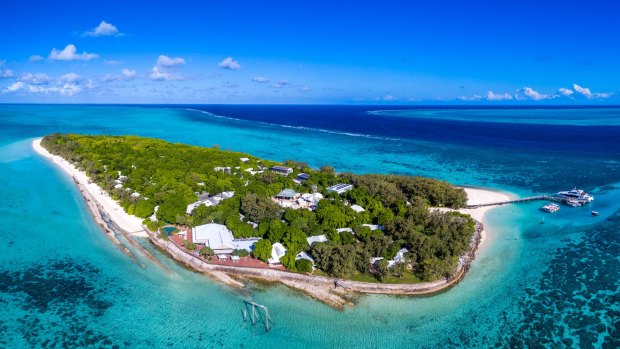
You can walk the circumference of Heron Island in an hour.Credit: James Vodicka
Mid-morning on a perfect island day, the sea surrounding Heron Island looks like glass and it's cut by a turtle bobbing its head up and down in the water as if it is greeting me. For the next 45 minutes with my snorkel, I splash into the underwater world of the reef. Corridors along the ocean floor are decorated with pastel-coloured corals reaching for the sunlit surface of the sea. Big, colourful schools of fish represent every colour of the rainbow and then some. Striking are the long, narrow trumpet fish and the schools of transparent squid, only recognisable from their huge central eyes, with sparkling patches of blue catching the sun's rays as they glide past. One of the reef's most vivid characters are clams that grace the ocean's floors: their shells prised shut with velvety, royal purples and indigo blues, no two the same. In some kind of weird, 20000-leagues-under-the sea-type superpower, the sound of fish chomping at the coral is amplified as are the waves over me lapping the reef's edge.
This remote Australian island paradise is one of the only places visitors can stay directly on the Great Barrier Reef, and snorkel from its white sand beaches. Measuring just 800 metres long and 300 metres wide, you can walk its circumference in an hour, viewing marine life from its shores. It houses a resort, a research centre and a shipwreck breakwater, the foreground for its nightly show-stopping sunsets.
The resort is not your typical; rooms are a place to a bunker down for the night before rising for pre-dawn nature walks to catch nesting turtles. The rooms have no keys, so there's nothing to lose when you go swimming, snorkelling, diving or reefwalking, just a handful of the island's daily activities on offer.
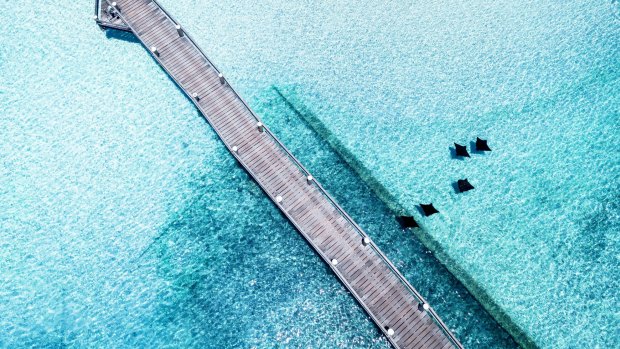
A fever of rays swim under the jetty.Credit: James Vodicka
A daily boat tour anchors at the reef's edge for snorkellers and divers, which I do the first morning after my arrival by seaplane and it gives unsurpassed views of the island and the surrounding reef.
The underwater world is not just for snorkellers – you can view this magical underwater world from anywhere along the island's perimeter, spying lemon and black-tip sharks as they dart through the water, and fevers of spotted eagle rays splashing in the shallows. From the jetty, several species of turtles entertain guests, including green turtles and huge loggerheads.
The only thing to fear here are seagulls, a mutant strain that enjoyed hovering over my head unannounced and letting out a long, loud squawk, scaring the bejesus out of me. If these warning squawks are left unheeded I could be scrubbing something unpleasant off my hat later. But with so many birds on the island regenerating its unique vegetation, it's probably unfair to point the finger squarely at the gulls.
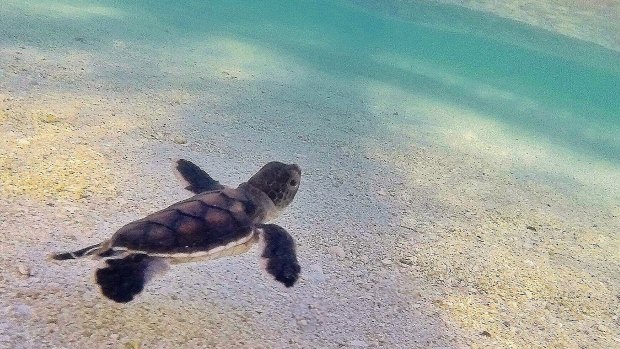
A turtle hatchling makes it into the ocean.Credit: James Vodicka
Watching the rats-of-the-sea do battle over tiny turtle hatchlings – the stars of the show here on Heron – just as they're about to launch themselves into the water only fuels my loathing of them all the more.
Between 30 and 150 turtles nest at Heron every night between November and March, laying 120 eggs, returning every few weeks to lay some more. The eggs take 55 days to incubate, and the hatchlings emerge throughout January to May.
Should they survive the land-lubbing predators, the turtlings launch themselves into the ocean and are quite often ushered straight into the mouths of sharks, who circle the shallows waiting for their freshly-hatched dinner.
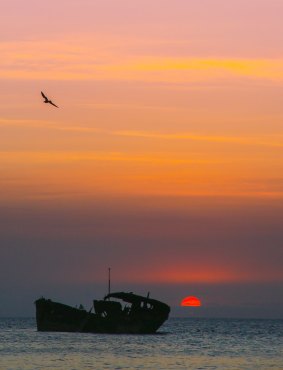
Sunset over the shipwreck.Credit: Kylie McLaughlin
Circle of life and all that.
The bad news is about one out of every 1000 hatchlings survive against the odds. The good news is you wouldn't know it from the number of turtles you see swimming in the shallows near the island. Around high tide, at dusk, the females laboriously make their way out of the water and up to the sandy dunes to nest, leaving huge monster-truck-tyre-style tracks in the sand making it easy for visitors to locate them. Once she's found the right spot, the digging commences; stand clear, or you'll end up with an eyeful of grit. Using her back fins as a scoop, she'll dig a deep hole for the eggs and lay for about half an hour before making her way back into the ocean. The eggs incubate for two months the babies will crack open their shells and dig their way out of the sand, an "eruption" of thousands of little critters pouring out of a sandy hole, and the whole cycle starts over again.
TRIP NOTES
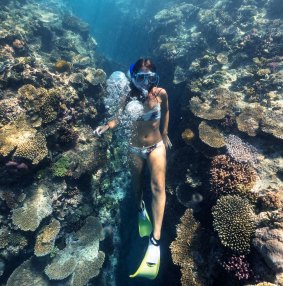
Snorkelling along the reef.Credit: James Vodicka
Getting there
From Melbourne and Sydney, Virgin flies directly to Brisbane. From here, they codeshare with Alliance Air for the connection to Gladstone, your departure point to Heron Island. See virginaustralia.com.au
The island is located two hours by ferry and there is a bus that connects the airport to the ferry terminal, where guests check in to the island.
Alternatively, guests can fly to the island via seaplane or helicopter, which takes about 30 minutes. Holiday packages are available, see heronisland.com/stay/getting-here
Holiday packages are available: call 1800 875 343 or see heronisland.com
The writer was a guest of Virgin and Heron Island Resort; virginaustralia.com.au; heronisland.com
FIVE MORE THING TO DO ON HERON
Tour the Research Station: The University of Queensland's Heron Island Research Station is conducting fascinating and necessary research into the effects of warm waters on coral and ways they might rehabilitate the reef. There's also a 'touch tank' which allows visitors to get their hands on a few of the Reef's locals such as clams and sea slugs.
Reef walk: Take advantage of the free tours with the island's passionate biologists and learn about the corals and creatures living on the ocean floor around Heron, while spotting a few creatures you may ordinarily miss.
Sunset cruise: This is a great way to meet other travellers from around the world over cheese and wine while watching the sunset over the island.
Aqua Soul Spa: After a few days of snorkelling, diving or just walking the island's sand perimeter, a good massage is just the ticket to wind down. This is a brand new facility at Heron is a cool oasis of calm and relaxation.
Nature presentations: Beat the heat and learn about the island's manta rays, sharks and turtles by attending daily presentations held by the island's biologists.
Sign up for the Traveller Deals newsletter
Get exclusive travel deals delivered straight to your inbox. Sign up now.